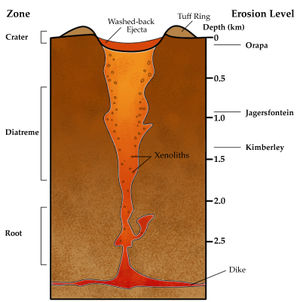Volcanic pipe
2008/9 Schools Wikipedia Selection. Related subjects: Geology and geophysics
Volcanic pipes are subterranean geological structures formed by the violent, supersonic eruption of deep-origin volcanoes. They are considered to be a type of diatreme. Volcanic pipes are composed of a deep, narrow cone of solidified magma (described as "carrot-shaped"), and are usually largely composed of one of two characteristic rock types — kimberlite or lamproite. These rocks reflect the composition of the volcanoes' deep magma sources, where the Earth is rich in magnesium. Volcanic pipes are relatively rare. They are well known as the primary source of diamonds, and are mined for this purpose.
Formation
Volcanic pipes form as the result of violent eruptions of deep-origin volcanoes. These volcanoes originate at least three times as deep as most other volcanoes, and the resulting magma that is pushed toward the surface is high in magnesium and volatile compounds such as water and carbon dioxide. As the body of magma rises toward the surface, the volatile compounds transform to gaseous phase as pressure is reduced with decreasing depth. This sudden expansion propels the magma upward at rapid speeds, resulting in a shallow supersonic eruption. A useful analogy to this process is the uncorking of a warm or shaken bottle of champagne.

Kimberlite pipes
In kimberlite pipes, the eruption ejects a column of overlying material directly over the magma column, and does not form a large above-ground elevation as typical volcanoes do; instead, a low ring of ejecta known as a tuff ring forms around a bowl-shaped depression over the subterranean column of magma. Over time, the tuff ring may erode back into the bowl, leveling out the depression by filling it with washed-back ejecta. Kimberlite pipes are the source of most of the world's commercial diamond production, and also contain other precious gemstones and semi-precious stones, such as garnets, spinels, and peridot.
Lamproite pipes
Lamproite pipes operate similarly to kimberlite pipes, except that the boiling water and volatile compounds contained in the magma act corrosively on the overlying rock, resulting in a broader cone of eviscerated rock (the ejection of this rock also forms a tuff ring, like kimberlite eruptions). This broad cone is then filled with volcanic ash and materials. Finally, the degassed magma is pushed upward, filling the cone. The result is a martini-glass shaped deposit of volcanic material (both solidified magma, and ejecta) which appears mostly flat from the surface.
